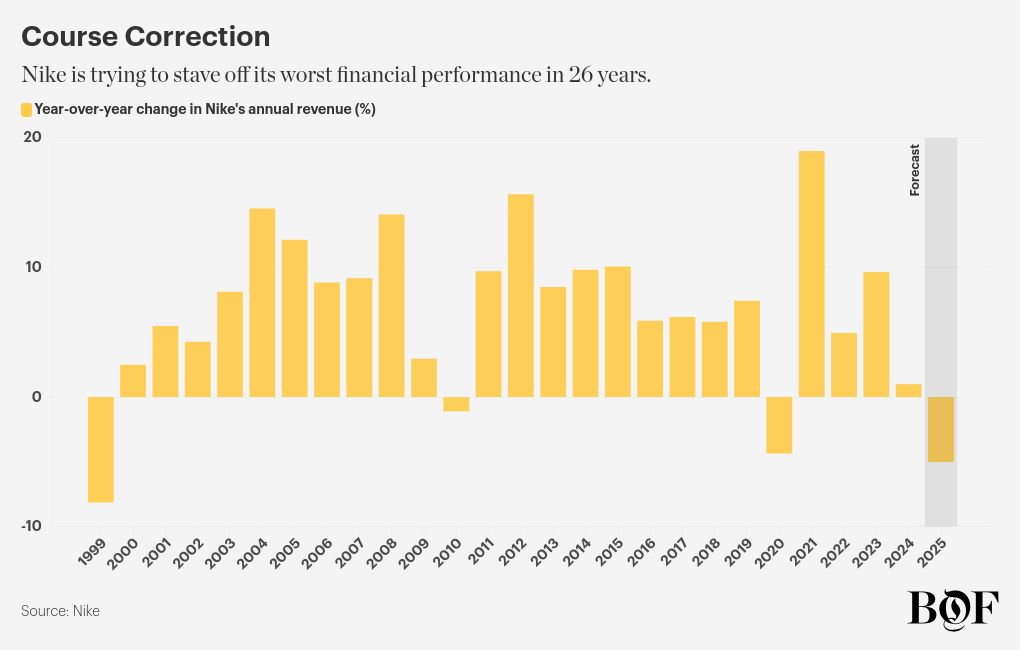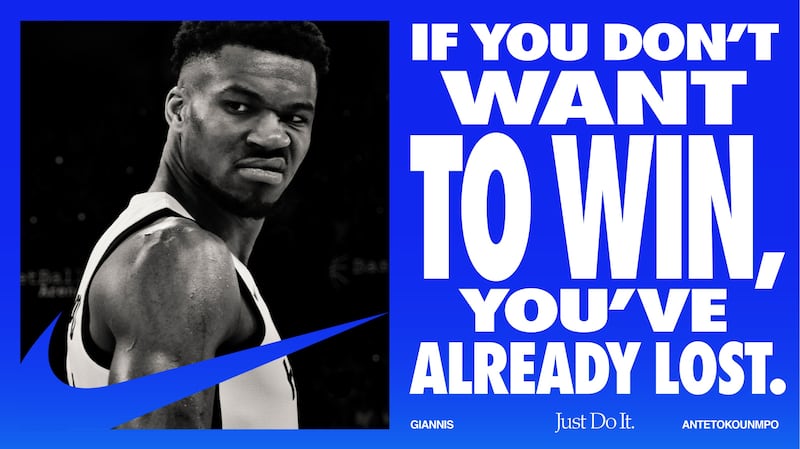
This time Nike was ready.
The American sportswear giant, which in its heyday hit marketing gold by mining its links to a pantheon of god-like athletes, had grown slow to celebrate their victories on social media, at times taking more than an hour after a win to post. But just minutes after the US women’s basketball team clinched its eighth straight Olympic gold on Sunday, Nike posted a clip celebrating the victory.
The video featured slow-motion training shots of Nike-sponsored stars A’ja Wilson, Brittney Griner and Sabrina Ionescu, with a voiceover by US basketball great Diana Taurasi. “It’s inspiring when we think about it: every four years, teams come from around the world to compete… for second place,” Taurasi said before the slogan “Winning Isn’t for Everyone” flashed on the screen.
The clip was part of a wider campaign that marked a bold return to celebrating the virtues of winning after the company’s marketing had veered in a softer, less competitive direction which critics say contributed to sending the brand off course, resulting in a historic slump in performance at a time when Nike was already under attack from increasingly agile and dynamic competitors.
The identity crisis began in the wake of a 2018 leadership shakeup that led to the exit of several top executives, including Trevor Edwards, president of the Nike brand, and continued as John Donahoe took the reins as chief executive in 2020.
Now, Nike veteran Nicole Hubbard Graham, a close associate of Edwards who rejoined the company as CMO in January, is co-piloting a push to restore the brand’s marketing glory with a playbook that takes a page from its golden era.
“The world went through some unprecedented moments,” Hubbard Graham told BoF. “Do I think Nike — along with a lot of other people — stopped believing that the power and magic of sport and the notion of winning could continue to grow this brand? Maybe.”
The New (Old) Nike
Nike’s wider “Winning Isn’t for Everyone” campaign, launched just before the start of the Olympics, asked whether star Nike-sponsored athletes, including LeBron James, Simone Biles and Cristiano Ronaldo, were “bad people” for wanting to win at all costs.
It was a significant vibe shift from the less combative, more inclusive tone Nike has struck in recent years, directly challenging the “everyone’s a winner” mentality that had taken hold in wider American culture in a way that harked back to the bold ads of the brand’s glory days.
“In a world where wanting to win has got a losing reputation, ‘Winning Isn’t for Everyone’ speaks to the grit, determination and sacrifice athletes say is required to get to the top of their sport,” the company said when the campaign launched.
The campaign wasn’t designed to be liked by everybody, said Hubbard Graham, who returned to Nike at a precarious time for the brand. The company is on the back foot and by its own projections could be headed for its worst financial performance in 25 years. In June, Nike said it expected revenues to fall “mid-single digits” in fiscal 2025, sending its share price plunging.
Sneaker fans, analysts, marketing experts and an increasingly vocal body of current and former employees now openly criticise the brand’s leadership. Some have called for “regime change,” pointing to missteps by current CEO John Donahoe, who succeeded longtime chief Mark Parker in 2020 amid an exodus of veteran designers, marketing gurus and executives.
Donahoe has taken a more efficiency-focused, data-led approach to running the company. Together with president of consumer, product and brand Heidi O’Neill, he has also implemented a major restructuring of the company around men’s, women’s and kids’ lines instead of sports categories like running and basketball — alienating design and marketing talent with experience in specific sporting communities, leading to more generic work — and pressed ahead with what proved to be an overly radical pivot to DTC sales. Product innovation has slowed. But most galling to many has been the watering down of Nike’s brand marketing.
In July, Massimo Giunco, a former Nike executive whose 21-year tenure ended in 2022, published an essay on LinkedIn accusing leadership of ripping up the playbook that underpinned the company’s success. Among other observations, he lamented Nike’s decision, as part of its focus on DTC, to ramp up investment in performance marketing over the kind of brand marketing that doesn’t just push products but creates consumer desire.
Nike still spends huge amounts on brand marketing, of course: in the financial year ended May 2024, the brand spent $4.3 billion on “demand creation,” according to regulatory filings. But whether the company’s message was cutting through the clutter was another matter.
Recently, Nike has made attempts to hire back company veterans to key roles. Tom Peddie, who retired in 2020, recently returned as vice president of marketplace partners to rebuild relationships with retailers. But the return of Hubbard Graham, who took a hands-on approach to shaping the “Winning Isn’t for Everyone” campaign, has sparked the most visible shift at the company thus far.
(Also key to the campaign’s conception was Enrico Balleri, a close associate of Hubbard Graham who was recently recalled from a regional role in Milan to the company’s Beaverton, Oregon, headquarters to lead brand storytelling.)
“Excuse me while I block your shot. #WinningIsntForEveryone,” NBA Rookie of the Year Victor Wembanyama captioned a recent Instagram post showing him swatting away an opponent’s shot during one of France’s early Olympics games.
The high-visibility, inherently inclusive nature of the Olympics was a risky time for Nike to implement its vibe shift, but perhaps that was the point. “You have to use these moments,” Hubbard Graham said. “I know bringing this point of view was going to be a lightning rod at the Olympics, and it just felt like a very important moment to remind people what this brand stands for.”
Is Winning For Nike?
Beyond re-energising Nike’s marketing message, Hubbard Graham’s mandate includes building closer relations between the company’s marketing, product and innovation functions.
She reports to O’Neill, and said her closest relationships in the business are with John Hoke and Martin Lotti, chief innovation officer and chief design officer respectively, who are increasingly plugged into how Nike is talking with consumers and vice versa. The dialogue between product and marketing teams is now “pretty early on in the process,” Hubbard Graham said.
“If you want to create an impact as a marketer, as a cultural brand, you can’t do things in silos. I’m in Martin’s product reviews, he sits in on my creative reviews — I wanted us to be directly responsible for the tone of our brand because winning as a brand today means being very specific,” she said.

So far, the new campaign appears to be hitting the mark.
Ellie Bamford, chief strategy officer for North America at marketing agency VML, said “Winning Isn’t for Everyone” recalled slogans such as “You don’t win silver, you lose gold” and “If you’re not here to win, you’re a tourist” from Nike’s 1996 Olympics campaign. “It did stand out because it had more edge than they’ve had in recent years,” she said of the latest campaign. “This is their DNA.”
“This is the Nike I love,” commented one Instagram user on Nike’s video celebrating the US women’s basketball team. “Nike has been on a generational run the entire Olympics,” said another.
Better marketing alone won’t solve Nike’s problems. The product mix also needs attention. The company is pulling back on distribution of oversupplied sneaker franchises like Air Forces and Dunks, while ramping up on increasingly popular silhouettes like the Killshot, Field General and Vomero. It also needs to mend relationships with major retailers like Footlocker and Dick’s Sporting Goods and calm those in the company calling for leadership change.
None of this is going to happen overnight.
“Nike is no longer the Nike we knew 5 to 10 years ago. I’m not sure they have the personnel to turn this around any time soon,” wrote analyst Matt Powell in response to Giunco’s post on LinkedIn.
But Nike’s vibe shift is a significant step forward.
“What I saw from Nike during the Olympics was not simply marketing,” said John C Jay, former global executive creative director of Wieden+Kennedy, the company’s advertising agency of record. “I think what we witnessed was Nike in the process of an inner search for its soul… a brief for all actions to come.”
Additional reporting by Marc Bain and Vikram Alexei Kansara.


